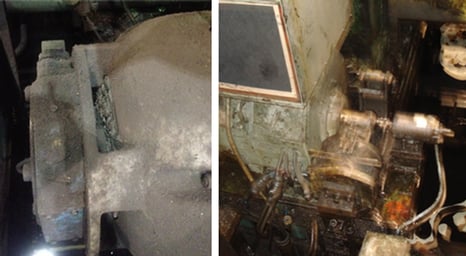This blog will introduce various metals industry encoder applications and the environmental and mechanical challenges they present.
Encoders are used in a wide range of metals applications:
- BOF Vessel Tilts
- Continuous Casters
- Pickle Lines
- Hot Rolling Mills
- Cold Rolling Mills
- Process Lines
These applications share some extremely challenging conditions for encoders. These can be grouped into Environmental Challenges and Mechanical Challenges:
I. Environmental Challenges
A. Oil, dirt and water get inside the encoder due to inadequate, fatigued or failed seals.
B. Extended high or low temperature operation causes premature seal and bearing failure.
C. Temperature cycling causes condensation inside the encoder.
Dirt, grease, water, oil and temperature are all challenges that must be addressed and overcome in order for metals encoder applications to attain the reliability the industry demands.
II. Mechanical Challenges
A. The bearings fail due to various stresses.
B. Precise internal alignments get disturbed causing erratic operation.
C. Internal components may work loose or shatter during vibration or impact.

Heavy impact shock loading and severe vibration can destroy encoder bearings, upset encoders’ precise internal alignments and required for encoders. With enough external forces on the encoder, significant internal damage is likely if the encoder is not designed to withstand the rigors of metals industry usage.
Here are some of the challenges associated with the metals encoder applications listed above:
BOF Vessel Tilts
These have all of the common challenges in one application. Heavy shock and vibration, temperature extremes, temperature cycling and dirt all combine to make this one of the industry’s toughest encoder applications.
Casters
A potent combination of heat and dirt make the caster an extreme encoder application. Extended high-temperature operation alone presents a significant challenge in cooling the encoder. At the same time, the encoders have to be sealed enough to prevent dirt from entering yet breathe enough to allow pressure equalization for production/downtime temperature cycling.
Hot Rolling Mills
For the main mill motors, the size and low speed range of the motor, the need for a mechanical overspeed switch and the requirement for multiple signals to different control systems can make simply mounting encoders difficult. But they are also exposed to severe impact shock loads and heavy vibration during rolling operations. The combination poses a challenging set of problems in spite of the area being relatively clean and temperature controlled.
The auxiliary motors are located on the mill floor and are directly exposed to dirt, rolling oil and cooling water. They share the same impact shock load and vibration as the main motors.
Cold Rolling Mills
The main motors are on the mill floor in most cold rolling applications as opposed to the motor rooms found in typical hot mill installations. They share the challenges found in the size and low speed range of the motor and the need for a mechanical overspeed switch.
Process Lines
Process Line Bridle applications have high-degrees of shock and vibration present. Many of the challenges these cause are amplified by the requirement of multiple signals for different control systems and drum brakes for holding strip tension.
For more detailed information about rotary sensors in the metals industry, download our white paper here:
Interested in regular updates about rotary sensors in the metals industry, including the pros and cons of tach-generators, incremental encoders, selsyns, resolvers and absolute encoders? Sign up for our blog update here:

